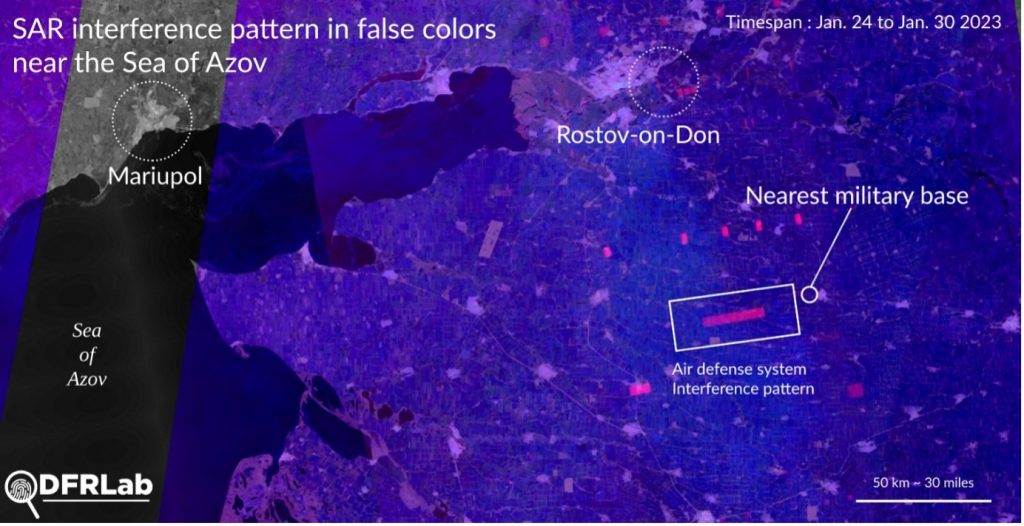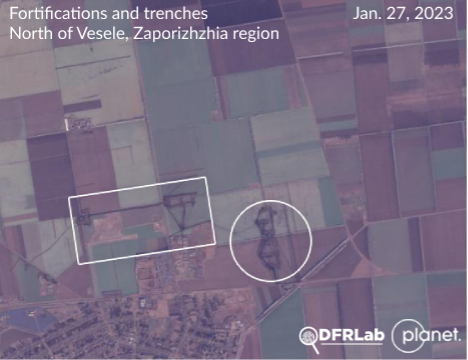As Russia continues its assault on Ukraine, the Atlantic Council’s Digital Forensic Research Lab (DFRLab) is keeping a close eye on Russia’s movements across the military, cyber, and information domains. With more than seven years of experience monitoring the situation in Ukraine—as well as Russia’s use of propaganda and disinformation to undermine the United States, NATO, and the European Union—the DFRLab’s global team presents the latest installment of the Russian War Report.
Security
Satellite imagery indicates a build-up of air defense missile systems in southern Russia
Ukraine defense minister warns of new Russian offensive
New Russian fortifications indicate a spring offensive could be on the horizon
Tracking narratives
Russia alleges US bioweapons created COVID, targets Ukrainians
Pro-Russia Telegram channels target Israel following Iran strike
Italy targeted by Russian accusations as Rome prepares new weapons package for Ukraine
Satellite imagery indicates a build-up of air defense missile systems in southern Russia
Satellite imagery reviewed by the DFRLab suggests a new build-up of air defense missile systems in Russia’s southern military region between Rostov-on-Don and Krasnodar. The DFRLab used radar imagery forensics to detect and approximate the relocation of air defense systems near the Azov Sea. As noted by University College London Professor Ollie Ballinger, missile batteries tend to cast recognizable turbulence signals on radar imagery when their systems are activated. This phenomenon has also been documented in the Middle East and the Baltic Sea.
The Sentinel-1 satellite of the European Space Agency collects satellite imagery using radar technology. As military systems also use radar electromagnetic wavelengths in the 5gHz range, referred to as the C-Band in NATO nomenclature, these are exploitable as open-source evidence for military activity and weapons deployment.

The DFRLab monitored for deployments of such systems near a field south of Oktyabrskaya in Russia’s Krasnodar Oblast. These systems were likely located close to a military airbase. While the DFRLab cannot confirm their presence in this area nor identify the exact systems, other interference signal patterns along the eastern border of Luhansk and Donetsk could also be interpreted as evidence of more electromagnetic radar-casting defense systems.
—Valentin Châtelet, Research Associate, Brussels, Belgium
—Ruslan Trad, Resident Fellow for Security Research, Sofia, Bulgaria
Ukraine defense minister warns of new Russian offensive
Ukrainian Defense Minister Oleksii Reznikov warned that Russia might attempt to launch a new offensive before the first anniversary of the Ukraine invasion on February 24. According to Reznikov, Russia is concentrating as many as 500,000 troops along Ukraine’s borders, significantly exceeding the declared 300,000 soldiers. Reznikov speculated that the offensive could come from the east and the south simultaneously. The minister also emphasized that military assistance from allies is needed to repel a possible attack.
Ukrainian military intelligence also stated that Ukraine expects a new wave of fighting in the next two months. Meanwhile, Russian President Vladimir Putin held a meeting to discuss the restoration of infrastructure in Crimea, Belgorod, Bryansk, and Kursk following Ukrainian shelling. He noted that his administration is prioritizing ending Ukrainian shelling along border regions.
On the evening of February 1, Russian forces struck the center of Kramatorsk with a rocket. Three civilians were killed and more than 20 people were injured. At least eight apartments were damaged, with one destroyed.
Meanwhile, Russian offensive operations have restarted in various locations. In the direction of Kupiansk, the Russian army shelled Dvorichna, Synkivka, Ivanivka, Kyslivka, Kotlyarivka, Tabayivka, Pischane, Novoselivske, and Stelmakhivka. The Russian army continued to attack villages and pressed Ukraine’s army positions toward Lyman, Zaporizhzhia, Kherson, Vuhledar, Avdiivka, and Bakhmut.
—Valentin Châtelet, Research Associate, Brussels, Belgium
—Ruslan Trad, Resident Fellow for Security Research, Sofia, Bulgaria
New Russian fortifications indicate a spring offensive could be on the horizon
Russian armed forces have dug trenches in Zaporizhzhia and Kherson Oblasts that the DFRLab has reviewed extensively on social media and satellite imagery. The southern flank in the Russian-occupied Zaporizhzhia Oblast has seen a rise in the build-up of trenches and fortifications stretching from Polohy to Vesele. The DFRLab identified massive underground structures in three different locations, pointing at a Russian reinforcement in their southern positions.
On January 27, trenches stretching twenty-one kilometers and circling Berdyansk’s airport tipped off OSINT researchers to Russia’s expected escalation on the southern flank. The DFRLab identified and documented two other occurrences of defensive build-ups on the eastern bank of the Dnipro River.
Between mid-December and January 31, 2023, Russian soldiers dug up underground trenches in an odd-B shape in the vicinity of Vesele, a village forty kilometers northeast of Melitopol. The DFRLab identified two structures, along with other fortifications across neighboring fields north of Vesele. The other structure, located west of the underground trenches, seems to resemble a defense base immediately connected to the village by a road.

In Mykhailivka, a city facing Zaporizhzhia from the other side of the riverbank, the DFRLab located similar trenches and fortifications. These stretch up to fifteen kilometers long, protecting the entire city near the front line.
—Valentin Châtelet, Research Associate, Brussels, Belgium
—Ruslan Trad, Resident Fellow for Security Research, Sofia, Bulgaria
Russia alleges US bioweapons created COVID, targets Ukrainians
On January 30, Russia’s Ministry of Defense published a collection of conspiracy narratives alleging the United States operates a biological weapons program. The ministry published the initial text on the free and anonymous blogging platform telegra.ph, developed by Telegram for sharing long-form posts.
The post begins with allegations that the US is involved in the emergence and spread of COVID-19. It names various US agencies and Microsoft founder Bill Gates as key actors in the pandemic. The ministry claims to have acquired more than “20,000 documents, reference and analytical materials, as well as surveyed witnesses and participants of the US biological programs.” The post concludes that these materials “confirm that the Pentagon aimed at creating elements of a biological weapon, and testing it on the population of Ukraine and other countries along the perimeter of the Russian borders.”
The defense ministry shared some of its “evidence” via the cloud service Disk Yandex. The link contains three folders containing unverified documents. The folders are titled “virological studies,” “experiments on Ukrainian citizens and military,” and “Rift Valley fever epidemic.”
The Facebook account of the Russian embassy in the United States amplified the narrative and shared the documents. The documents also found their way to Kremlin propaganda platforms.
The DFRLab has tracked many instances of Russia spreading falsehoods about the US operating a biological weapons program since the start of the pandemic; Russia now employs similar narratives to justify its war against Ukraine.
—Eto Buziashvili, Research Associate, Tbilisi, Georgia
Pro-Russia Telegram channels target Israel following Iran strike
Pro-Russia Telegram channels targeted Israel following a suspected Israeli drone strike against an Iranian ammunition factory on January 28. A few weeks earlier, the United States sanctioned Iran’s defense and aviation sector for supplying Russia with drones that are being used against Ukraine.
The Telegram channels responded to the Iranian strike by spreading anti-Israel and antisemitic narratives. Russian military blogger Roman Saponkov endorsed calls for the “demilitarization of Israel.” The account Операция Z (“Operation Z”) used antisemitic expressions to describe Jewish people. Elsewhere, Kremlin propagandist Vladimir Solovyev shared a post accusing Israel of providing shelter to “Nazis from the ‘Azov’ terrorist group.” Other pro-war channels shared graphic photos with claims that Wagner had found the bodies of Israeli and Polish mercenaries fighting in Ukraine.
—Eto Buziashvili, Research Associate, Tbilisi, Georgia
Italy targeted by Russian accusations as Rome prepares new weapons package for Ukraine
Russia’s chief diplomat in Italy accused the country of engaging in anti-Russian discrimination, in an apparent attempt to pressure Italy to stop backing Ukraine and sway public opinion in favor of Russia. Earlier this week, Russian ambassador to Italy Sergey Razov published an open letter, ostensibly in response to comments made by Defense Minister Guido Minister Crosetto on why Ukraine needs international support. Razov accused the Italian government of putting in place “discriminatory restrictions” against Russian citizens. The letter was published on the Facebook account of the Russian embassy in Italy; at the time of writing, it had received more than 2,200 likes, 792 comments, and 698 reshares.
In January, Italian media outlet Decode39 reported that the Russian embassy in Italy had published a series of social media posts “targeting Italy’s supposed military supplies to Ukraine in a bid to cast doubt on Rome’s logistical support and its effectiveness on the battlefield.” The social media posts were widely reshared and amplified the Kremlin narrative that falsely paints Ukrainians as “neo-Nazis.”
Italy is poised to send a new package of military aid to Ukraine. “According to Defense Minister Crosetto, the package will contain air defense systems, namely Aspide surface-to-air missiles and the more advanced SAMP/T missile shield, of which some components will be supplied by Rome and others by Paris.
Mattia Caniglia, Associate Director for Capacity Building, Brussels